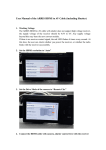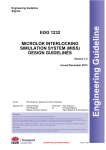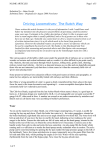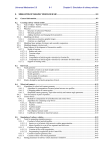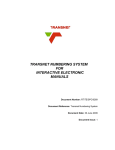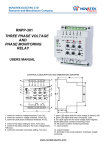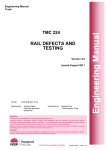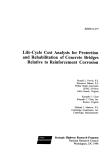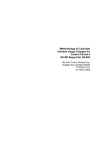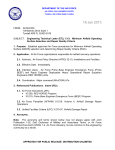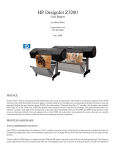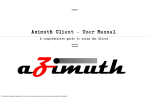Download ESR 0330 - Wheel defect manual
Transcript
ESR 0330 WHEEL DEFECT MANUAL Version 1.2 Issued May 2013 Owner: Technical Specialist Rolling Stock Performance Standards Approved by: Stephen White, A/Manager, Rolling Stock Access Integrity Authorised by: Michael Uhlig, A/Chief Engineer Rolling Stock Disclaimer This document was prepared for use on the RailCorp Network only. RailCorp makes no warranties, express or implied, that compliance with the contents of this document shall be sufficient to ensure safe systems or work or operation. It is the document user’s sole responsibility to ensure that the copy of the document it is viewing is the current version of the document as in use by RailCorp. RailCorp accepts no liability whatsoever in relation to the use of this document by any party, and RailCorp excludes any liability which arises in any manner by the use of this document. Copyright The information in this document is protected by Copyright and no part of this document may be reproduced, altered, stored or transmitted by any person without the prior consent of RailCorp. UNCONTROLLED WHEN PRINTED Page 1 of 57 Engineering Standard Engineering Standard Rolling Stock RailCorp Engineering Standard — Rolling Stock Wheel Defect Manual ESR 0330 Document control Version (RSU 212) 1.0 (RSU 212) 2.0 (RSS 0030) 1.0 (RSS 0030) 1.1 Date August 1997 April 2001 Jan 2004 July 2004 (RSS 0030) 1.2 October 2005 (RSS 0330) 1.0 May 2008 (ESR 0330) 1.0 (ESR 0330) 1.1 1.2 June 2010 July 2010 May 2012 Summary of change Based on Mechanical Branch Spec F163 and TRS 0163 Photos included & diagrams amended New standard. Content taken from RSU 212. Description of defects expanded Reissued as a Railcorp standard. Scaled wheel classes amended, witness marks altered, quick reference tables added. Standard moved to General Maintenance Standards and renumbered RSS 0330. Classes of Scaled wheels amended Reformatted and renumbered ESR 0330 Document revision history corrected Summary of changes from previous version Summary of change Version 1.2 Minor reformatting New section on rolling contact fatigue added New section on sub surface fatigue added Note added re minimum cut 10 mm for removing spalling Requirement for trim blocks on suburban and intercity cars with class 1 skidded wheels Requirement for trim blocks on suburban and intercity cars with class 2 skidded wheels Increase in speed for diesel and electric passenger trains to 115 km/h Actions required for Class 3 short flanges added New section on machining defects added New section on out of round wheels added © RailCorp Issued May 2013 UNCONTROLLED WHEN PRINTED Section 5.2 5.3 5.5.3 5.6.1 5.6.2 5.6.2 5.9.5.1 5.10 5.10.2 Page 2 of 57 Version 1.2 RailCorp Engineering Standard — Rolling Stock Wheel Defect Manual ESR 0330 Contents 1 Introduction .............................................................................................................................5 2 Purpose ....................................................................................................................................5 3 Application...............................................................................................................................5 4 4.1 Referenced documents ..........................................................................................................5 RailCorp standards ...................................................................................................................5 5 Wheel rim thickness ...............................................................................................................5 6 Permissible variation in wheel diameter...............................................................................6 7 7.1 Wheel defects ..........................................................................................................................8 Thermal cracks..........................................................................................................................8 7.1.1 Class 1 thermal cracks ..............................................................................................8 7.1.2 Class 2 thermal cracks ..............................................................................................9 7.1.3 Class 3 thermal cracks ............................................................................................10 7.1.4 Class 4 thermal cracks ............................................................................................11 7.1.5 Class 5 thermal crack ..............................................................................................12 7.1.6 Fractured wheel .......................................................................................................13 Rolling contact fatigue.............................................................................................................14 7.2.1 Class 1 rolling contact fatigue cracks ......................................................................14 7.2.2 Class 2 rolling contact fatigue cracks ......................................................................14 7.2.3 Class 3 rolling contact fatigue cracks ......................................................................15 7.2.4 Class 4 rolling contact fatigue cracks ......................................................................15 Sub surface fatigue .................................................................................................................17 Fatigue cracks.........................................................................................................................18 Spalling or shelled tread..........................................................................................................18 7.5.1 Class 1 spalling........................................................................................................19 7.5.2 Class 2 spalling........................................................................................................20 7.5.3 Class 3 spalling........................................................................................................21 7.5.4 Class 4 spalling........................................................................................................22 Skidded wheels (flats) .............................................................................................................23 7.6.1 Class 1 skidded wheels ...........................................................................................23 7.6.2 Class 2 skidded wheels ...........................................................................................23 7.6.3 Class 3 skidded wheels ...........................................................................................24 7.6.4 Class 4 skidded wheels ...........................................................................................25 7.6.5 Class 5 skidded wheels ...........................................................................................26 Scaled wheels .........................................................................................................................27 7.7.1 Class 3 scaled wheels .............................................................................................27 7.7.2 Class 4 scaled wheel ...............................................................................................28 7.7.3 Class 5 scaled wheels .............................................................................................29 Arrises .....................................................................................................................................30 7.8.1 Class 1 arris.............................................................................................................30 7.8.2 Class 2 arris.............................................................................................................30 7.8.3 Class 3 arris.............................................................................................................31 7.8.4 Class 4 arris.............................................................................................................32 Tread/flange wear ...................................................................................................................33 7.2 7.3 7.4 7.5 7.6 7.7 7.8 7.9 © RailCorp Issued May 2013 UNCONTROLLED WHEN PRINTED Page 3 of 57 Version 1.2 RailCorp Engineering Standard — Rolling Stock Wheel Defect Manual ESR 0330 7.9.1 7.10 7.11 Steep flanges...........................................................................................................33 7.9.1.1 Class 1 steep flange.................................................................................33 7.9.2 High flanges.............................................................................................................34 7.9.2.1 Class 3 high flange...................................................................................34 7.9.3 Hollow tread.............................................................................................................35 7.9.3.1 Class 3 hollow tread .................................................................................35 7.9.4 Thin flanges .............................................................................................................37 7.9.4.1 Class 4 thin flange....................................................................................37 7.9.4.2 Class 5 thin flange....................................................................................38 7.9.5 Short flange .............................................................................................................39 7.9.5.1 Class 3 short flange..................................................................................39 Damaged wheels ....................................................................................................................40 7.10.1 Manufacturing defects .............................................................................................40 7.10.2 Out of round wheels.................................................................................................42 7.10.3 External wheel damage ...........................................................................................42 7.10.4 Class 4 manufacturing defect or external wheel damage .......................................43 7.10.5 Overheated wheels..................................................................................................43 Miscellaneous .........................................................................................................................44 7.11.1 Misaligned brake gear .............................................................................................44 7.11.1.1 Temporary brake block overhang. ...........................................................44 7.11.1.2 Permanent brake block overhang. ...........................................................45 7.11.2 Weld repairs of wheel skids .....................................................................................45 7.11.3 Wheel tread profile remachining..............................................................................46 7.11.3.1 Surface finish............................................................................................46 7.11.3.2 Witness marks..........................................................................................46 7.11.3.3 Tolerance .................................................................................................46 7.11.4 Examination of tyred wheels in service ...................................................................46 8 Wheel gauges ........................................................................................................................47 9 Use of pony bogies ...............................................................................................................48 Appendix A © RailCorp Issued May 2013 Quick reference tables of wheel defects and actions........................................50 UNCONTROLLED WHEN PRINTED Page 4 of 57 Version 1.2 RailCorp Engineering Standard — Rolling Stock Wheel Defect Manual 1 ESR 0330 Introduction Wheels with defective wheels may cause damage to both the track and the vehicle or lead to derailment. 2 Purpose This standard provides staff with a summary of wheel conditions under which wheels may continue in service and operating restrictions imposed for defective wheels found on vehicles operating on the RailCorp network. 3 Application This standard is intended for use by train crew, vehicle maintainers and engineering staff for any vehicle operating on the RailCorp network. 4 Referenced documents 4.1 RailCorp standards 5 ESR 0331 Wheel and axle reference manual ESR 0334 Welding of skidded wheels in situ ESR 0311 Single car air test Wheel rim thickness A rail vehicle shall not remain in service if it has a wheel rim thickness less than the limits specified below, with reference to Figure 1 • Freight vehicles up to 25 tonne axleload 20 mm • Freight vehicles over 25 tonne axleload 22 mm • Passenger vehicles 25 mm • Locomotives 22 mm (See below) Locomotive wheel rim thickness may be dictated by bogie component clearances, such as gearboxes, above the rolling stock outline © RailCorp Issued May 2013 UNCONTROLLED WHEN PRINTED Page 5 of 57 Version 1.2 RailCorp Engineering Standard — Rolling Stock Wheel Defect Manual Figure 1 6 ESR 0330 Standard wheel terminology Permissible variation in wheel diameter On freight vehicles, the wheel diameter variation on wheelsets, bogies, and between bogies fitted to vehicles shall be as per the limits specified in the ROA Manual of Engineering Standards and Practices, section 24.2.1.3 (e), (f), (g), as stated below: • Maximum permissible variation in wheel tread diameter per axle (new or re-turned) 0.5mm • Maximum permissible variation in wheel tread diameter per axle (in service) 1mm • Maximum permissible variation in wheel tread diameter per bogie 25mm • Maximum permissible variation in wheel tread diameter per vehicle 60mm © RailCorp Issued May 2013 UNCONTROLLED WHEN PRINTED Page 6 of 57 Version 1.2 RailCorp Engineering Standard — Rolling Stock Wheel Defect Manual ESR 0330 On locomotives, locomotive hauled passenger cars and multiple unit rolling stock, the diameter variations on wheels shall be in accordance with vehicle manufacturer’s requirements, but they shall not exceed the limits in dot points 2 and 3 above. TREAD CENTRE LINE 70 mm Figure 2 © RailCorp Issued May 2013 Location of limiting dimensions UNCONTROLLED WHEN PRINTED Page 7 of 57 Version 1.2 RailCorp Engineering Standard — Rolling Stock Wheel Defect Manual 7 ESR 0330 Wheel defects This specification details the allowable limits for the inspection of all rail vehicle wheels for various tread and flange defects. The text outlines the action to be taken when defects are found. Allowable speeds mentioned below are not to exceed the prevailing track speed limit. The accompanying series of instructions and associated diagrams are included to indicate degrees of severity of wheel tread damage likely to be found and the appropriate action to be taken in each case. 7.1 Thermal cracks Thermal cracks are the result of alternate heating and cooling of the wheel tread and rim area, and originate from metallurgical changes in the wheel material. Thermal cracks are the most severe form of wheel defect. Heating from brake blocks when braking frequently produces a fine network of fine, shallow, superficial lines or "checks" running in many different directions on the wheel tread surface. Because of its similarity to the type of fine cracks found in pottery glazes, it is sometimes referred to as surface crazing. This should not be confused with true thermal cracking, and if found on its own causes no problems. Thermal cracks are usually transverse, across the wheel tread, and, if allowed to grow without corrective action, can develop to the point where the wheel will fracture. Many shallow thermal cracks can be removed by machining but extra care must be used to ensure that the crack has been completely eliminated in the operation. If thermal cracks are found on a wheel, then the vehicle's brake system should be checked for evidence of dragging brakes (sticking brakes). Important: If there is the slightest doubt as to the severity of the thermal crack, always report the higher classification. (For example, if the defect description falls between a class 2 and 3 thermal crack, then a class 3 thermal crack would be reported). 7.1.1 Class 1 thermal cracks Any thermal cracks up to 10 mm long on the tread surface within the zone shown in Figure 2 but not on or extending onto the rim face of the wheel. Action Required: No action required for class 1 thermal cracking Rim Face 12mm Figure 3 Class 1 thermal crack zone Speed Restriction: No speed restriction. © RailCorp Issued May 2013 UNCONTROLLED WHEN PRINTED Page 8 of 57 Version 1.2 RailCorp Engineering Standard — Rolling Stock Wheel Defect Manual 7.1.2 ESR 0330 Class 2 thermal cracks Any thermal cracks between 10 mm and 30 mm long in the zone shown in Figure 3. Figure 4 Class 2 thermal crack zone Action Required: Locomotives and passenger vehicles: Any wheels with class 2 thermal cracks must have inspection details recorded by the Operator to ensure that the wheel condition is identified as soon as it progresses to a class 3 thermal crack. Freight vehicles: If any class 2 thermal cracks are found, the examining officer shall re examine the wheel during vehicle examination/inspection and maintenance. No other action is required for class 2 thermal cracks. Speed restriction:no speed restriction Photograph 1 - Class 2 thermal crack © RailCorp Issued May 2013 UNCONTROLLED WHEN PRINTED Page 9 of 57 Version 1.2 RailCorp Engineering Standard — Rolling Stock Wheel Defect Manual 7.1.3 ESR 0330 Class 3 thermal cracks Any thermal cracks over 30 mm and up to 40 mm long in the zone shown in Figure 4. Note: Any vehicle found with a class 3 thermal crack which has the wheel approaching the condemning diameter (i.e. less than 6 mm left on the tread above the condemning dimension), must be treated as if it had a class 4 defect. Figure 5 Class 3 thermal crack zone Action Required: Locomotives and passenger vehicles with class 3 thermal cracks must be scheduled for wheel turning within 14 days of detection. Electric multiple unit vehicles with class 3 thermal cracks may defer wheel turning provided the wheels are inspected and details recorded by the Operator every 14 days to ensure they have not progressed to a class 4 thermal crack. Freight vehicles with class 3 thermal cracks must be worked out of service for repairs. Speed restriction: No speed restriction Photograph 2 - class 3 thermal crack © RailCorp Issued May 2013 UNCONTROLLED WHEN PRINTED Page 10 of 57 Version 1.2 RailCorp Engineering Standard — Rolling Stock Wheel Defect Manual 7.1.4 ESR 0330 Class 4 thermal cracks Any thermal crack greater than 10 mm long in the shaded zone adjacent to the rim face, or any visible thermal crack on the flange shaded zone, as shown in Figure 5 or a thermal crack greater than 40 mm long anywhere on the wheel tread. This is a serious defect which can result from extended heavy braking or periods of abnormal braking, for instance in the case of overhanging brake blocks. Note: If there is any evidence of a crack on or extending onto the rim face, then this condition will be considered a class 4 defect. Under no circumstances must a wheel with this defect be allowed to enter service if found at a pre-trip examination or at a depot. Any visible crack on Flange Figure 6 Cracks greater than 40 mm long anywhere on the wheel tread Cracks greater than 10 mm long Class 4 thermal crack zone Photograph 3 - class 4 thermal crack © RailCorp Issued May 2013 UNCONTROLLED WHEN PRINTED Page 11 of 57 Version 1.2 RailCorp Engineering Standard — Rolling Stock Wheel Defect Manual ESR 0330 Action Required: If the defect is found en-route or at a location with no repair facility, the vehicle may continue through to the scheduled destination and/or be transferred to the nearest depot at a speed of not more than 40 km/h providing the brakes are isolated (passenger and freight) or the use of independent brake can be kept to an absolute minimum (locomotives). If these restrictions unduly affect operations, the vehicle must be immediately removed from service. The vehicle may then be repaired (bogie/wheelset change) at the location where the defect was found. Speed Restriction: 40 km/h. 7.1.5 Class 5 thermal crack Any crack running through the rim, web or boss of the wheel must be considered as a class 5 defect. Action Required: The vehicle shall not be moved until the damage has been examined and assessed by the attending Qualified Worker. After examination, the vehicle may be allowed to clear the section at the speed nominated by the attending mechanical maintenance officer. Speed Restrictions: Vehicle not to be moved until inspected. Photograph 4 Once the vehicle is in a siding, it shall not be further moved until: the fitting of a pony bogie; or a wheelset/bogie change. Once the vehicle has had a wheelset/bogie change, it may be returned to service. © RailCorp Issued May 2013 UNCONTROLLED WHEN PRINTED Page 12 of 57 Version 1.2 RailCorp Engineering Standard — Rolling Stock Wheel Defect Manual 7.1.6 ESR 0330 Fractured wheel A fractured wheel is a Class 5 defect. A fractured wheel may be the result of either a thermal crack or a fatigue crack which has propagated or grown. Photograph 5 Fractured wheel caused by thermal crack Action Required: This vehicle shall not be moved until: • a wheelset/bogie change; or the fitting of a pony bogie, or • a pony bogie is fitted. Speed Restrictions: Vehicle not to be moved © RailCorp Issued May 2013 UNCONTROLLED WHEN PRINTED Page 13 of 57 Version 1.2 RailCorp Engineering Standard — Rolling Stock Wheel Defect Manual 7.2 ESR 0330 Rolling contact fatigue Rolling contact fatigue cracks is caused by repeated contact stress during the rolling motion. Rolling contact fatigue cracks usually develop on rhe tread surface and are generally not oriented perpendicular to the running direction. This type of defect can lead to spalling. 7.2.1 Class 1 rolling contact fatigue cracks Any rolling contact fatigue cracks up to 10 mm long on the tread surface within the zone shown in Figure 2 but not on or extending onto the rim face of the wheel (see clause 7.1.3). Action Required: No action required for class 1 rolling contact fatigue cracking Rim Face 12mm Figure 7 Class 1 rolling contact fatigue crack zone Speed Restriction: No speed restriction. 7.2.2 Class 2 rolling contact fatigue cracks Any rolling contact fatigue cracks between 10 mm and 30 mm long in the zone shown in Figure 8 Class 2 rolling contact fatigue crack zone Action Required: Locomotives and passenger vehicles: Any wheels with class 2 rolling contact fatigue cracks must have inspection details recorded by the Operator to ensure that the wheel condition is identified as soon as it progresses to a class 3 rolling contact fatigue crack. Freight vehicles: If any class 2 rolling contact fatigue cracks are found, the examining officer shall re-examine the wheel during vehicle examination/inspection and maintenance. No other action is required for class 2 rolling contact fatigue cracks. Speed restriction:no speed restriction © RailCorp Issued May 2013 UNCONTROLLED WHEN PRINTED Page 14 of 57 Version 1.2 RailCorp Engineering Standard — Rolling Stock Wheel Defect Manual 7.2.3 ESR 0330 Class 3 rolling contact fatigue cracks Any rolling contact fatigue cracks over 30 mm and up to 40 mm long in the zone shown in Figure 4. Note: Any vehicle found with a class 3 rolling contact fatigue crack which has the wheel approaching the condemning diameter (i.e. less than 6 mm left on the tread above the condemning dimension), must be treated as if it had a class 4 defect. Figure 9 Class 3 rolling contact fatigue crack zone Action Required: Locomotives and passenger vehicles with class 3 rolling contact fatigue cracks must be scheduled for wheel turning within 14 days of detection. Electric multiple unit vehicles with class 3 rolling contact fatigue cracks may defer wheel turning provided the wheels are inspected and details recorded by the Operator every 14 days to ensure they have not progressed to a class 4 rolling contact fatigue crack. Freight vehicles with class 3 rolling contact fatigue cracks must be worked out of service for repairs. Speed restriction: No speed restriction 7.2.4 Class 4 rolling contact fatigue cracks Any rolling contact fatigue crack greater than 10 mm long in the shaded zone adjacent to the rim face, or any visible rolling contact fatigue crack on the flange shaded zone, as shown in Figure 5 or a rolling contact fatigue crack greater than 40 mm long anywhere on the wheel tread. This is a serious defect which can result from extended heavy braking or periods of abnormal braking, for instance in the case of overhanging brake blocks. Note: If there is any evidence of a crack on or extending onto the rim face, then this condition will be considered a class 4 defect. Under no circumstances must a wheel with this defect be allowed to enter service if found at a pre-trip examination or at a depot. © RailCorp Issued May 2013 UNCONTROLLED WHEN PRINTED Page 15 of 57 Version 1.2 RailCorp Engineering Standard — Rolling Stock Wheel Defect Manual ESR 0330 Photograph 6 Class 4 Rolling contact fatigue Note: Cracks are angled across the wheel tread and may vary up to 45 degrees. Any visible crack on Flange Figure 10 Cracks greater than 40 mm long anywhere on the wheel tread Cracks greater than 10 mm long Class 4 rolling contact fatigue crack zone Action Required: Under no circumstances shall a wheel with a class 4 defect be allowed to enter service if found at a pre-trip examination or at a depot. If the defect is found en-route or at a location with no repair facility, the vehicle may continue through to the scheduled destination and/or be transferred to the nearest depot at a speed of not more than 40 km/h providing the brakes are isolated (passenger and freight) or the use of independent brake can be kept to an absolute minimum (locomotives). If these restrictions unduly affect operations, the vehicle must be immediately removed from service. The vehicle may then be repaired (bogie/wheelset change) at the location where the defect was found. Speed Restriction: 40 km/h. © RailCorp Issued May 2013 UNCONTROLLED WHEN PRINTED Page 16 of 57 Version 1.2 RailCorp Engineering Standard — Rolling Stock Wheel Defect Manual 7.3 ESR 0330 Sub surface fatigue Sub surface fatigue cracks initiate from metallurgical defects in the wheel. The cracks generally develop 3 to 25 mm below the tread surface in the region of maximum shear stress in the wheel/rail contact area. Sub surface defects are normally identified by ultrasonic testing; however there are three visual ways to identify a sub surface fatigue defect. Cracks appear on the tread or flange during wheel turning. Cracks appear on the rim or back of the wheel and these cracks will be circumferential. A portion of the tread may be displaced and protrude past the wheel rim. Any sub surface crack running through the rim, web, boss or back of wheel that can be visually identified is to be treated as a Class 4 or 5 defect, depending on severity. Photograph 7 Sub surface fatigue crack (identified during wheel turning) Photograph 9 Sub surface fatigue crack Note: protrusion on chamfer/rim of wheel © RailCorp Issued May 2013 Photograph 8 Sub surface fatigue crack (extending to back of wheel) Photograph 10 Sub surface fatigue crack propagated to surface UNCONTROLLED WHEN PRINTED Page 17 of 57 Version 1.2 RailCorp Engineering Standard — Rolling Stock Wheel Defect Manual 7.4 ESR 0330 Fatigue cracks Fatigue cracks generally originate from a defect in the wheel. These defects can be caused by either external damage or a manufacturing defect. Fatigue cracks usually appear as a solitary crack and must not be confused with thermal cracks. Photograph 11 Class 5 Fatigue Crack (propagated from a thermal crack) Action Required: Any fatigue crack found in a wheel must be classified as a class 4 defect (see clause 7.10.4) or a class 5 defect (see clause 7.1.5). Speed Restrictions: 40 km/h for Class 4, vehicle not to be moved for Class 5. 7.5 Spalling or shelled tread Spalling or shelled tread occurs when pieces of metal break out of the tread surface in several places more or less continuously around the tread circumference. This defect can result from thermal damage, skidding or over-stressing at the wheel-rail contact point. It is usually attributed to a combination of two or more of the following factors: poor track and excessive speed resulting in high impact stresses, excessive vertical loads, excessive braking (thermal damage and/or skidding) or the use of wheels of insufficient hardness. Spalls can range in size depending on the age and depth of the defect. Their frequency can be such that the entire tread circumference is covered with craters to the extent that they become joined. Wheel tread condition, particularly spalling, has a pronounced effect on wheel and brake block life. For example, brake block wear is approximately 1.5mm per 1000km travelled with new wheels and extreme spalling can increase this rate to approximately 20mm per 1000 km. Pitting is the presence of very small marks on the tread. It can be the initial stages of spalling but is not in itself a concern. Important: If there is the slightest doubt as to the severity of spalling, always report the higher classification. © RailCorp Issued May 2013 UNCONTROLLED WHEN PRINTED Page 18 of 57 Version 1.2 RailCorp Engineering Standard — Rolling Stock Wheel Defect Manual 7.5.1 ESR 0330 Class 1 spalling The wheel tread is mostly smooth with minor visible flaws or a blotchy appearance. Pitting may also be noticed. Areas of spalling up to 12 mm diameter may be scattered on up to 10% of the total tread area. Photograph 12 Action Required: No action required. However, Trim Blocks or cast iron brake blocks may be used to dress the wheel tread surface. Speed Restriction: No speed restriction. © RailCorp Issued May 2013 UNCONTROLLED WHEN PRINTED Page 19 of 57 Version 1.2 RailCorp Engineering Standard — Rolling Stock Wheel Defect Manual 7.5.2 ESR 0330 Class 2 spalling The spalling has progressed such that the spalled areas are up to 25 mm diameter. The total coverage may be up to 20% of the total tread area and the edges of the spalls may be sharp and jagged. Photograph 13 Action Required: Locomotives and passenger vehicles: Any wheels with class 2 spalling must have inspection details recorded by the operator to ensure that the wheel condition is identified as soon as it progresses to class 3 spalling. Freight vehicles: If any class 2 spalls are found, the examining officer shall re-examine the wheel during vehicle examination/inspection or maintenance. No other action is required for class 2 spalling. No speed restriction for any vehicle with class 2 spalling. However, Trim Blocks or cast iron brake blocks may be used to dress the wheel tread surface. Speed Restriction: No speed restriction. © RailCorp Issued May 2013 UNCONTROLLED WHEN PRINTED Page 20 of 57 Version 1.2 RailCorp Engineering Standard — Rolling Stock Wheel Defect Manual 7.5.3 ESR 0330 Class 3 spalling The spalling has progressed such that the spalled areas are larger than 25 mm diameter. These spalls may cover up to 50% of the total tread area and will be sharp edged and jagged. Photograph 14 Action Required: Locomotives and passenger vehicles must have inspection details recorded by the operator and be scheduled for wheel turning within 14 days of detection. Note: The minimum 10 mm depth of cut at required when turning wheels. Freight vehicles must be worked out of service for repairs. No speed restriction for any vehicle with class 3 spalling. Speed Restriction: No speed restriction. © RailCorp Issued May 2013 UNCONTROLLED WHEN PRINTED Page 21 of 57 Version 1.2 RailCorp Engineering Standard — Rolling Stock Wheel Defect Manual 7.5.4 ESR 0330 Class 4 spalling Extensive spalling of greater than 50% of wheel surface area coverage or large spall areas 3 mm or more deep. Spalling of any size on wheel flanges is a class 4 defect. Any circular cracks associated with the early stages of spalling are also a class 4 defect. Photograph 15 Action Required: Under no circumstances must a wheel with this defect be allowed to enter service if found at a pre-trip examination or at a depot. If the defect is found en-route or at a location with no repair facility, the vehicle may continue through to the scheduled destination and/or be transferred to the nearest depot at a speed of not more than 40 km/h providing the brakes are isolated (passenger and freight) or the use of independent brake can be kept to an absolute minimum (locomotives). If these restrictions unduly affect operations, the vehicle must be immediately removed from service. The vehicle may then be repaired (bogie/wheelset change) at the location where the defect was found. Bogies which have had wheels in this condition shall have their running gear thoroughly examined for evidence of loose or adrift components particularly in the axlebox and traction motor areas. Bearings shall be rumble tested and visually inspected with the removal of the front cover or gas plug. Speed Restriction: 40 km/h. © RailCorp Issued May 2013 UNCONTROLLED WHEN PRINTED Page 22 of 57 Version 1.2 RailCorp Engineering Standard — Rolling Stock Wheel Defect Manual 7.6 ESR 0330 Skidded wheels (flats) Skids occur when a wheel "locks up" while the vehicle is moving. All skids eventually lead to further wheel damage such as spalling and reduce the life of bogie components such as bearings. Impact forces produced by a skid are also detrimental to the track structure. Important: If there is the slightest doubt as to the severity of skidding, always report the higher classification. Skids may be ground to reduce the severity to the next lower category. A single car air test (Refer to ESR 0311) must be carried out on vehicles with skidded wheels. 7.6.1 Class 1 skidded wheels A single skid with length less than 25 mm. Action Required: No action required for locomotives or freight vehicles. However, Trim Blocks or cast iron brake blocks may be used to dress the wheel tread surface. Trim blocks must be fitted to suburban and intercity cars with class 1 skids. Speed Restriction: No speed restriction. 7.6.2 Class 2 skidded wheels Single skid length between 25 mm and 40 mm or multiple class 1 skids Action Required: Passenger vehicles: Any wheels with class 2 skids must be fitted with trim blocks. Locomotives: Any wheels with class 2 skids must have inspection details recorded by the operator to ensure that the wheel condition is identified as soon as it progresses to a class 3 skid. Freight vehicles: If any class 2 skids are found the examining officer shall re-examine the wheel during vehicle examination/inspection or maintenance. No other action is required for class 2 skids. However, Trim Blocks or cast iron brake blocks may be used to dress the wheel tread surface. Speed Restriction: Diesel and electric passenger trains 115 km/h, all other vehicles 80 km/h. © RailCorp Issued May 2013 UNCONTROLLED WHEN PRINTED Page 23 of 57 Version 1.2 RailCorp Engineering Standard — Rolling Stock Wheel Defect Manual 7.6.3 ESR 0330 Class 3 skidded wheels Single skid length between 40 mm and 60 mm or multiple class 2 skids. A speed restriction of 40 km/h must be placed on any vehicle with class 3 skids Action Required: Locomotives and passenger vehicles must have inspection details recorded by the operator and be scheduled for wheel turning. Freight vehicles must be worked out of service for repairs. Speed Restriction: 40 km/h. Photograph 16 Class 3 skidded wheel Photograph 17 Class 3 skidded wheel (note build up of scale) © RailCorp Issued May 2013 UNCONTROLLED WHEN PRINTED Page 24 of 57 Version 1.2 RailCorp Engineering Standard — Rolling Stock Wheel Defect Manual 7.6.4 ESR 0330 Class 4 skidded wheels Single skid length between 60 mm and 100 mm or multiple class 3 skids. Photograph 18 Action Required: Under no circumstances must a wheel with this defect be allowed to enter service if found at a pre-trip examination or at a depot. If the defect is found en-route or at a location with no repair facility, the vehicle may continue through to the scheduled destination and/or be transferred to the nearest depot at a speed of not more than 25 km/h providing the brakes are isolated (passenger and freight) or the use of independent brake can be kept to an absolute minimum (locomotives). If these restrictions unduly affect operations, the vehicle must be immediately removed from service. The vehicle may then be repaired (bogie/wheelset change) at the location where the defect was found. Speed Restriction: 25 km/h. © RailCorp Issued May 2013 UNCONTROLLED WHEN PRINTED Page 25 of 57 Version 1.2 RailCorp Engineering Standard — Rolling Stock Wheel Defect Manual 7.6.5 ESR 0330 Class 5 skidded wheels Single skid greater than 100 mm in length or multiple class 4 skids. Action Required: This vehicle shall not be moved until the tread surface defect is adequately rectified. This can be achieved by in situ welding and build up of the tread defect area followed by grinding to restore a uniform profile. Refer to ESR 0334 Welding of skidded wheels in situ. After rectifying the defect in the section, ensure that the vehicle movement is to the nearest siding at the speed which the attending mechanical maintenance officer nominates. Once the vehicle is in the siding, it shall not be further moved until: • the wheel profile has been completely restored; or • a wheelset/bogie change; or the fitting of a pony bogie. • a pony bogie is fitted, the vehicle shall then be transferred to the nearest wheel lathe in accordance with section 9. Upon reaching the wheel lathe the defective wheel is to be reprofiled to ensure all weld metal and the heat affected zone is removed. In practice this can be achieved by machining the wheel such that the radius is reduced by an amount no less than the skid length divided by eight (8). Bogies which have had wheels in this condition shall have their running gear thoroughly examined for evidence of loose or adrift components particularly in the axlebox and traction motor areas. Bearings shall be rumble tested and visually inspected with the removal of the front cover or gas plug. The vehicle brake system shall also be tested for correct operation and sensitivity. Speed Restriction: Vehicle not to be moved. Photograph 19 Class 5 skidded wheel © RailCorp Issued May 2013 UNCONTROLLED WHEN PRINTED Page 26 of 57 Version 1.2 RailCorp Engineering Standard — Rolling Stock Wheel Defect Manual 7.7 ESR 0330 Scaled wheels Scaling is the build up of metallic material on the surface of the wheel tread. It is usually attributed to sticking brakes which cause the wheel to slip or slide on the rail, thus heating it to the stage where the material becomes soft enough to flow on the tread surface. It mixes with brake dust and other foreign material and is deposited back onto the wheel where it cools in layers, giving the tread a scaly appearance. Scaling may cover the entire wheel surface or any part of it. The method used to determine the severity of any given scaling is to measure its height from the normal wheel surface. A single car air test (Refer to ESR 0311 must be carried out on vehicles with scaled wheels. Important: If there is the slightest doubt as to the severity of scaling, always report the higher classification. Note: Class 1 scaled wheel and Class 2 scaled wheel classifications are not relevant. 7.7.1 Class 3 scaled wheels Light surface smearing, very light scale may be present. Scale height too small to measure with a standard rule (less than 1 mm). This smearing effect is caused by the wheel sliding, but not completely stopping, for a very short time. Photograph 20 - Class 3 scaled wheel Action Required: No action is required at this stage although the brake system should be examined for defects which could cause the wheels to over-brake. No speed restriction for any vehicle with class 1 scale. However, Trim Blocks may be used on multiple unit trains and cast iron brake blocks on locomotives and locomotive hauled vehicles to dress the wheel tread surface. Speed Restriction: No speed restriction. © RailCorp Issued May 2013 UNCONTROLLED WHEN PRINTED Page 27 of 57 Version 1.2 RailCorp Engineering Standard — Rolling Stock Wheel Defect Manual 7.7.2 ESR 0330 Class 4 scaled wheel Measurable scale height not exceeding 15 mm. Photograph 21 - Class 4 scaled wheel Action Required: Under no circumstances must a wheel with this defect be allowed to enter service if found at a pre-trip examination or at a depot. If the defect is found en-route or at a location with no repair facility, the vehicle must clear the section subject to the following speed restrictions: scale height 1 mm up to 5 mm:- 25 km/h maximum scale height greater than 5 mm up to 10 mm:- 15 km/h maximum scale height greater than 10 mm up to 15 mm:- 5 km/h maximum providing the brakes are isolated (passenger and freight) or the use of independent brake can be kept to an absolute minimum (locomotives). Once the section has been cleared, the vehicle shall not be further moved until: • the scale build-up has been completely removed by grinding, chiselling, etc.; or • a wheelset/bogie change; or • the fitting of a pony bogie. If a pony bogie is fitted, the vehicle shall then be transferred to the nearest depot in accordance with section 9. Upon reaching the depot/workshop, an abrasive brake block may be used to clean the tread and restore it to unrestricted operation as per ESR 0315 Bogies which have had wheels with class 4 scale must have their running gear thoroughly examined for evidence of loose or adrift components particularly in the axlebox and traction motor areas. The vehicle brake system shall also be checked for correct operation and sensitivity. Speed Restriction: 25 km/h, 15 km/h or 5 km/h – see above. © RailCorp Issued May 2013 UNCONTROLLED WHEN PRINTED Page 28 of 57 Version 1.2 RailCorp Engineering Standard — Rolling Stock Wheel Defect Manual 7.7.3 ESR 0330 Class 5 scaled wheels Scale height greater than 15 mm. Photograph 22 Class 5 scaled wheel Photograph 23 Class 5 scaled wheel (extreme) Note: scale over the flange Action Required: The vehicle is not to be moved until the tread surface defect is adequately rectified. This can be achieved by in-situ grinding or chiselling. After rectifying the defect in the section, ensure that the vehicle is moved to the nearest siding at a speed which is applicable for class 4 scaled wheels. Once the vehicle is in the siding, it shall not be further moved until: • the scale build-up has been completely removed by grinding, chiselling, etc.; or • a wheelset/bogie change; or • the fitting of a pony bogie. If a pony bogie is fitted, the vehicle shall then be transferred to the nearest depot in accordance with clause 9. Bogies which have had wheels with class 5 scale must have their running gear thoroughly examined for evidence of loose or adrift components particularly in the axlebox and traction motor areas. Bearings shall be rumble tested and visually inspected with the removal of the front cover or gas plug. The vehicle brake system shall also be checked for correct operation and sensitivity. Wheel treads shall be examined for any evidence of thermal cracking. Speed Restriction: Vehicle not to be moved. © RailCorp Issued May 2013 UNCONTROLLED WHEN PRINTED Page 29 of 57 Version 1.2 RailCorp Engineering Standard — Rolling Stock Wheel Defect Manual 7.8 ESR 0330 Arrises An aris is formed when flange metal has rolled towards the tip of the flange causing a step with a sharp point at the flange tip. Photograph 24 Photograph 24 View of arris from outside of wheel 7.8.1 Wheel with arris (note flange wear) Class 1 arris This classification is not relevant. 7.8.2 Class 2 arris A class 2 arris is less than or equal to 1.5 mm high. Action Required: No action required for a wheel with a class 2 arris. Note: A class 2 arris in conjunction with a steep flange is a class 4 defect. Up to 1 mm high above the tip of the flange and where the arris is rolled Up to 1.5 mm high above the tip of the flange and h th i i ll d b k Figure 11 - Class 2 arris Speed Restriction: No speed restriction. © RailCorp Issued May 2013 UNCONTROLLED WHEN PRINTED Page 30 of 57 Version 1.2 RailCorp Engineering Standard — Rolling Stock Wheel Defect Manual 7.8.3 ESR 0330 Class 3 arris A class 3 arris is greater than 1.5 mm high. Wheel flange tips such as these should be removed either by wheel turning, the use of an abrasive block or by some suitable grinding operation. A distinct corner produced by a flat on the flange tip in combination with a steep flange running face. See Section 4.8 on Steep Flanges From 1 mm up to 1.5 mm high above the tip of the flange and extending from the flange running face. See Section 4.8 on Steep Flanges Over 1.5 mm high above the tip of the flange and where the arris is rolled back towards the flange tip. Figure 12 - Class 3 arris Note: A class 2 or greater arris in conjunction with a steep flange is a class 4 defect. Action Required: Locomotives and passenger vehicles must have inspection details recorded by the operator and be scheduled for wheel turning within 14 days of detection. Freight vehicles must be worked out of service for repairs. As a temporary measure the arris may be hammered down at the location to allow vehicle movement as per a lower classification of defect. Speed Restriction: No speed restriction. © RailCorp Issued May 2013 UNCONTROLLED WHEN PRINTED Page 31 of 57 Version 1.2 RailCorp Engineering Standard — Rolling Stock Wheel Defect Manual 7.8.4 ESR 0330 Class 4 arris The combination of a near vertical flange running face and an arris greater than 1.5 mm high can split incorrectly housed points and result in a derailment. Greater than 1.5 mm high above the tip of the flange and extending from a steep running face. See Section 4.7 on Steep Flanges New wheel profile Figure 13 - Class 4 arris Note: A class 2 arris in conjunction with a steep flange is a class 4 defect. Action Required: Under no circumstances must a wheel with this defect be allowed to enter service if found at a pre-trip examination or at a depot. If the defect is found en-route or at a location with no repair facility, the vehicle may continue through to the scheduled destination and/or be transferred to the nearest depot at a speed of not more than 40 km/h over normal track and at not more than 25 km/h over points, turnouts or crossings. If these restrictions unduly affect operations, the vehicle must be immediately removed from service. The vehicle must then be repaired (bogie/wheelset change) at the location where the defect was found. As a temporary measure the arris may be hammered down at the location to allow vehicle movement as per a lower classification of defect. The arris may be ground off for a permanent measure. Speed Restriction: 40 km/h. © RailCorp Issued May 2013 UNCONTROLLED WHEN PRINTED Page 32 of 57 Version 1.2 RailCorp Engineering Standard — Rolling Stock Wheel Defect Manual 7.9 T read/flange wear 7.9.1 S teep flanges ESR 0330 A visual examination of the wheel will be necessary to determine if it has a steep flange. Note: Class 2 steep flange, class 3 steep flange, class 4 steep flange and class 5 steep flange classifications are not relevant. A steep flange in conjunction with a class 2 arris is a class 4 defect as per section 7.8.4. 7.9.1.1 Class 1 steep flange Action Required: No action required. Speed Restriction: No speed restriction for any vehicle with steep flanges where not associated with an arris. A flange is considered to be steep when the flange face angle in this area is 5 degrees or less to the vertical. 16 mm above the tread line Figure 14 - Steep flange © RailCorp Issued May 2013 UNCONTROLLED WHEN PRINTED Page 33 of 57 Version 1.2 RailCorp Engineering Standard — Rolling Stock Wheel Defect Manual 7.9.2 ESR 0330 High flanges A visual examination of the wheel will be necessary to determine if it has a high flange. Note: Class 1 high flange, class 2 high flange, class 4 high flange and class 5 high flange classifications are not relevant. 7.9.2.1 Class 3 high flange High flanges exceed a height of 35 mm. Figure 15 Class 3 high flange Action Required: Vehicles found with a high flange at a depot or pre trip shall not be permitted to enter service. Where the flange height exceeds 35 mm the following action applies: Locomotives and passenger vehicles must have inspection details recorded by the operator and be scheduled for wheel turning within 14 days of detection. Freight vehicles must be worked out of service for repairs. Speed Restrictions: No speed restriction for any vehicle with high flanges. When the hook gauge touches the flange tip the flange is too high 35 mm maximum flange height 70 mm Figure 16 - Application of flange height gauge Refer to Figure 18 for flange height and thin flange gauge © RailCorp Issued May 2013 UNCONTROLLED WHEN PRINTED Page 34 of 57 Version 1.2 RailCorp Engineering Standard — Rolling Stock Wheel Defect Manual 7.9.3 ESR 0330 Hollow tread A visual examination of the wheel will be necessary to determine if a hollow tread is evident. Note: Class 1 hollow tread, class 2 hollow tread, class 4 hollow tread and class 5 hollow tread classifications are not relevant. Photograph 25 Tread wear showing hollow tread 7.9.3.1 Class 3 hollow tread The maximum permissible tread hollowing is 3 mm nominal, as determined using the wheel gauge as shown in Figure 11. Refer to Figure 20 for wheel hollow tread gauge. Action Required: Locomotives and passenger vehicles must have inspection details recorded by the operator and be scheduled for wheel turning within 14 days of detection. Freight vehicles must be worked out of service for repairs. Speed Restrictions: No speed restriction for any vehicle with a hollow tread. © RailCorp Issued May 2013 UNCONTROLLED WHEN PRINTED Page 35 of 57 Version 1.2 RailCorp Engineering Standard — Rolling Stock Wheel Defect Manual ESR 0330 Any gap at this point indicates excessive tread hollowing 70 mm 120 mm The maximum allowable tread hollowing shall be 0.5 mm, measured below the highest point on the outer tread surface, beyond the 120 mm dimension shown. Figure 17 - Application of hollow tread gauge © RailCorp Issued May 2013 UNCONTROLLED WHEN PRINTED Page 36 of 57 Version 1.2 RailCorp Engineering Standard — Rolling Stock Wheel Defect Manual 7.9.4 ESR 0330 Thin flanges A visual examination of the wheel will be necessary to determine if a thin flange is evident. Note: Class 1 thin flange, class 2 thin flange, and class 3 thin flange classifications are not relevant. 7.9.4.1 Class 4 thin flange The minimum allowable flange thickness is 19 mm. Figure 18 - Thin flange The recommended method for detecting a thin flange is using a flange height and thin flange gauge. (see Figure 18) A thin flange will be detected when the end of the gauge touches the tread surface of the wheel. Action Required: Under no circumstances must a wheel with a flange thickness of 19 mm or less be allowed to enter service if found at a pre-trip examination or at a depot. If a vehicle is found with a wheel flange thickness of less than 19 mm, to a minimum of 18 mm, en-route or at a location with no repair facility, the vehicle may continue through to the scheduled destination and/or transferred to the nearest depot at a speed of not more than 40 km/h. Note: In this case any arris present on the flange must be removed completely. Speed Restrictions: 40 km/h © RailCorp Issued May 2013 UNCONTROLLED WHEN PRINTED Page 37 of 57 Version 1.2 RailCorp Engineering Standard — Rolling Stock Wheel Defect Manual 7.9.4.2 ESR 0330 Class 5 thin flange If this portion of the gauge touches the wheel tread, the flange is too thin Figure 19 - Application of thin flange gauge Refer to Figure 18 for flange height and thin flange gauge Action Required: If a vehicle is found with a wheel flange thickness of less than 18 mm the vehicle must be immediately removed from service. Speed Restrictions: Vehicle not to be moved. © RailCorp Issued May 2013 UNCONTROLLED WHEN PRINTED Page 38 of 57 Version 1.2 RailCorp Engineering Standard — Rolling Stock Wheel Defect Manual 7.9.5 ESR 0330 Short flange A visual examination of the wheel will be necessary to determine if a short flange is evident. Note: Class 1 short flange, class 2 short flange, class 4 short flange, and class 5 short flange classifications are not relevant. 7.9.5.1 Class 3 short flange In some cases where rapid flange wear takes place, without significant tread wear, a worn wheel profile is produced having a ramp at the root of the flange. This ramp effectively shortens the flange thereby allowing the gauge corner of the rail to work closer to the flange tip. This arrangement reduces the safety margin for wheel climb derailments. The short flange gauge is designed to arrest this phenomenon before it becomes critical. The flange is too short if clearance exists here between the gauge and the tip of the flange, after removal of any arris. For a correct indication, the short flange gauge must be in contact with the wheel tread and flange at these two points. Figure 20 - Application of short flange gauge Action Required: Locomotives and passenger vehicles must have inspection details recorded by the operator and be scheduled for wheel turning within 14 days of detection. Freight vehicles must be worked out of service for repairs. Speed Restrictions: No speed restriction for any vehicle with a short flange. Refer to Figure 20 for short flange gauge. © RailCorp Issued May 2013 UNCONTROLLED WHEN PRINTED Page 39 of 57 Version 1.2 RailCorp Engineering Standard — Rolling Stock Wheel Defect Manual 7.10 Damaged wheels 7.10.1 Manufacturing defects ESR 0330 This type of defect generally occurs on the wheel web and can result in a fatigue crack which propagates circumferentially around the web. In other cases, defects have led to large pieces of the flange falling off in service. W37 type freight wheels originating in New South Wales, (these are fitted with 18R or 9R axleboxes), are particularly prone to manufacturing defects and should be specifically examined for cracks. Although this type of wheel has essentially been phased out of service, some wheels may still be in service. Action Required: Any crack originating from a manufacturing defect shall be classified as a class 4 or greater defect (see clause 7.10.4). Speed Restrictions: 40 km/h. Photograph 26 badly turned wheel resulting incorrect turning process © RailCorp Issued May 2013 UNCONTROLLED WHEN PRINTED Page 40 of 57 Version 1.2 RailCorp Engineering Standard — Rolling Stock Wheel Defect Manual ESR 0330 Photograph 27 badly turned wheel resulting incorrect mill feed Photograph 28 badly turned wheel resulting from impact from foreign object © RailCorp Issued May 2013 UNCONTROLLED WHEN PRINTED Page 41 of 57 Version 1.2 RailCorp Engineering Standard — Rolling Stock Wheel Defect Manual ESR 0330 Photograph 29 badly turned wheel resulting from impact from foreign object 7.10.2 Out of round wheels One type of machining defect is wheels that have been turned out of round, for example, if the mill cutter has not been fed in correctly or the wheel tread has not been turned concentric to the axle centre. Out of round wheels (≥ 0.3 mm) have been detected on the WILD (wheel impact load detector) sites. Action Required: These wheels must be returned to the wheel lathe and returned. Speed Restrictions: 40 km/h. 7.10.3 External wheel damage This type of damage generally occurs as the result of a heavy impact on the wheel and may show up as a chip or gouge in the wheel flange or a bruise on the wheel tread. A fatigue crack can start at this defect and propagate quickly through the entire wheel. Action Required: A close visual examination must be made of both flange surfaces and the wheel tread in order to detect the presence of any damage. Any chip or gouge in a wheel which is more than 25 mm long and/or 12 mm wide shall be classified as a class 4 defect (see clause 7.10.4). Speed Restrictions: 40 km/h. © RailCorp Issued May 2013 UNCONTROLLED WHEN PRINTED Page 42 of 57 Version 1.2 RailCorp Engineering Standard — Rolling Stock Wheel Defect Manual 7.10.4 ESR 0330 Class 4 manufacturing defect or external wheel damage Under no circumstances shall a wheel with a class 4 defect be allowed to enter service if found at a pre-trip examination or at a depot. Action Required: If the defect is found en-route or at a location with no repair facility, the vehicle may continue through to the scheduled destination and/or be transferred to the nearest depot at a speed of not more than 40 km/h providing the brakes are isolated (passenger and freight) or the use of independent brake can be kept to an absolute minimum (locomotives). If these restrictions unduly affect operations, the vehicle must be immediately removed from service. The vehicle may then be repaired (bogie/wheelset change) at the location where the defect was found. Speed Restriction: 40 km/h. 7.10.5 Overheated wheels Any wheel which has become severely overheated due to excessive braking or dragging brakes is a class 4 defect. An overheated wheel can be identified by a blueing discolouration, and may be evident after a skidded wheel or dragging brake incident. Action Required: Under no circumstances shall a wheel with a class 4 defect be allowed to enter service if found at a pre-trip examination or at a depot. If the defect is found en-route, or at a location with no repair facility, the vehicle may continue through to the scheduled destination, and /or be transferred to the nearest depot at a speed of not more than 40 km/h, providing the brakes are isolated (passenger and freight) or the use of independent brake can be kept to an absolute minimum (locomotives). If these restrictions unduly affect operations, the vehicle must be immediately removed from service. The vehicle shall then be repaired (bogie/wheelset change) at the location where the defect was found. Wheels which have been severely overheated must be thoroughly inspected for possible thermal defects and checked for changes in metallurgical structure. If there is any doubt as to the structural integrity of the wheel, and the heat affected area cannot be removed by machining, then the wheel must be scrapped. Overheated tyred wheels must be removed from service and replaced immediately. Speed Restrictions: 40 km.h. © RailCorp Issued May 2013 UNCONTROLLED WHEN PRINTED Page 43 of 57 Version 1.2 RailCorp Engineering Standard — Rolling Stock Wheel Defect Manual 7.11 Miscellaneous 7.11.1 Misaligned brake gear ESR 0330 Inspection for overhanging brake blocks or misaligned brake gear must be carried out with the brakes applied. 7.11.1.1 Temporary brake block overhang. In the case where an overhanging brake block is found and there is no evidence of shouldering on the brake block or wheel tread and no evidence of class 4 thermal cracks, then the overhanging brake block may be a temporary condition. Consideration must be given to the lateral float of the wheelset together with brake rigging clearances to determine if the brake block is overhanging temporarily. If evidence suggests that the brake block overhang is temporary then the vehicle is suitable for service subject to regular inspections of the brake block(s) in question. Action Required: Locomotive and passenger vehicles with brake gear in this condition are to have the defect recorded and be inspected at the next routine inspection. On vehicles where brake rigging is tied together laterally there should be no excuse for overhanging brake blocks, and if found corrective action must be taken to adjust the rigging or replace worn components such as brake heads, pins and/or bushes. If there is evidence of any other wheel tread surface defect the vehicle shall be attended to as per the relevant section of this standard. Where non-metallic and/or segmented brake blocks are used, particular attention shall be paid to the presence of thermal cracks and skids. If a shoulder has worn on the edge of the brake block face, then action shall be as per clause 7.11.1.2. Important: Non-metallic blocks will not exhibit a pronounced shoulder as the overhanging area tends to break away before achieving any noticeable size unless the overhang is excessive. Speed Restrictions: No speed restriction. Figure 21 - Example of temporary overhanging brake block © RailCorp Issued May 2013 UNCONTROLLED WHEN PRINTED Page 44 of 57 Version 1.2 RailCorp Engineering Standard — Rolling Stock Wheel Defect Manual 7.11.1.2 ESR 0330 Permanent brake block overhang. An overhanging brake block is determined to be a permanent fault by evidence of a shoulder on the wheel tread, a shoulder on the brake block face and/or class 4 thermal cracking at the edge of the wheel tread. Action Required: The vehicle shall not be permitted to enter service until the matter is rectified Speed Restrictions: Vehicle not to enter service. Figure 16 - Example of permanent brake block overhang Figure 22 - False flange due to brake block overhang 7.11.2 Weld repairs of wheel skids The repair of wheel skids by welding is a temporary measure to allow recovery of a vehicle with class 5 wheel skids, as outlined in section 7.6.5. Refer to ESR 0334 for Welding of skidded wheels in situ. After weld repair the vehicle must proceed directly to the nearest repair facility for wheelset change or reprofiling. A suitable weld procedure must be developed for the repair. Notwithstanding this, welding shall be carried out circumferentially, not transversely across the tread. All surface irregularities and deposited weld metal shall be ground smooth to the contour of the wheel after the welded area has cooled to ambient temperature. The surface of the weld, and adjacent area shall be inspected for flaws prior to movement of the vehicle. Once the vehicle has been moved to a suitable repair location for wheel turning, all weld metal, including the heat effected zone, must be removed, and the wheel surface inspected for possible flaws, prior to replacing the vehicle into service. © RailCorp Issued May 2013 UNCONTROLLED WHEN PRINTED Page 45 of 57 Version 1.2 RailCorp Engineering Standard — Rolling Stock Wheel Defect Manual 7.11.3 Wheel tread profile remachining 7.11.3.1 Surface finish ESR 0330 It is important when remachining the wheel tread and flange profile that the surface finish be maintained within acceptable limits. This is to ensure that surfaces which can normally contact the rail and/or check rail are smooth, free of machine chatter marks, surface waviness or grooving, which could contribute to a wheel flange climb type derailment. The surface finish of the wheel tread and flange, after machining shall not exceed 12.5 μm (micrometres) RA (Roughness Average). Undercutting, grooving or waviness of the tread surface between the flange root radius and the outer edge of the tread, is permitted but shall not exceed 0.25 mm in depth below the true tread profile. Localised undercutting, grooving or waviness of the flange profile between the wheel tread side of the flange root radius and the back face of the wheel, is permitted but shall not exceed 0.25 mm in depth below the true flange profile. 7.11.3.2 Witness marks Witness marks used for an indication of machining efficiency, are permitted on the flange face, between a point 10mm above the wheel tread baseline and the tip of the flange but shall not exceed 6 mm in width. 7.11.3.3 Tolerance The tolerance of a remachined wheel tread and flange profile shall not deviate below the true profile by more than 0.25 mm. That is, it shall not be possible to insert a 0.25 mm feeler gauge beneath a profile gauge positioned on the wheel tread. 7.11.4 Examination of tyred wheels in service Tyred wheels must be inspected prior to each trip for relative movement between the tyre and wheel centre. If any relative movement is detected between the tyre and wheel centre, the vehicle must be immediately removed from service. © RailCorp Issued May 2013 UNCONTROLLED WHEN PRINTED Page 46 of 57 Version 1.2 RailCorp Engineering Standard — Rolling Stock Wheel Defect Manual 8 ESR 0330 Wheel gauges R 9.5 mm R 4 mm 35 mm R 2 mm 70 mm 4.5 mm 13 mm 24 mm Tolerance on dimensions +/- 0.2 mm Due to the introduction of the WPR 2000 wheel profile, these dimensions have been reduced by 1.5 mm to effectively maintain a 19 mm minimum flange thickness. Figure 23 Flange height and thin flange gauge – controlling dimensions 5 mm radius 5 mm 12 mm 10.5 mm 80 mm 5 mm radius Figure 24 Short flange gauge - controlling dimensions © RailCorp Issued May 2013 UNCONTROLLED WHEN PRINTED Page 47 of 57 Version 1.2 RailCorp Engineering Standard — Rolling Stock Wheel Defect Manual ESR 0330 35 mm 0.5 mm 70 mm 120 mm 35 mm Tolerance on dimensions marked * +/- 0.1 mm Tolerance on other dimensions +/- 0.2 mm Figure 25 Hollow tread gauge – controlling dimensions 9 Use of pony bogies When a vehicle is fitted with a pony bogie it shall be transferred to the nearest depot as follows: Defective locomotives, or loaded freight vehicles, supported by pony bogies must be accompanied by a suitably trained mechanical maintenance officer, who shall take every opportunity to examine the assembly and bearings. The speed for locomotives and loaded freight vehicles when mounted on pony bogies shall not exceed 15 km/h, reduced to 8 km/h over points and crossings. Empty freight and empty passenger type vehicles supported by pony bogies are permitted to travel unaccompanied at a maximum speed not exceeding 20 km/h, reduced to 10 km/h over points and crossings. © RailCorp Issued May 2013 UNCONTROLLED WHEN PRINTED Page 48 of 57 Version 1.2 RailCorp Engineering Standard — Rolling Stock Wheel Defect Manual ESR 0330 Photograph 30 Pony bogie assembled and in position Note: A pony bogie is used to move a Class 5 defect. © RailCorp Issued May 2013 UNCONTROLLED WHEN PRINTED Page 49 of 57 Version 1.2 RailCorp Engineering Standard — Rolling Stock Wheel Defect Manual Appendix A ESR 0330 Quick reference tables of wheel defects and actions Table 1 – Thermal cracks Class Description of defect 1 2 Speed restriction No action required Normal speed Re-examine carefully to ensure that no class 3 thermal cracks exist. Defects must be reported Normal speed If wheel is approaching condemning diameter, treat as class 4 defect. Locomotives & passenger vehicles: Defects must be recorded and scheduled for turning within 14 days. For EMU’s, turning may be deferred provided inspections monitor cracks before reaching class 4. Wagons: Green card “For Repairs” 3 4 5 Action required If found pre-trip or at a depot, the wheel must not enter service. If found enroute continue at reduced speed with the brakes cut out. Speed 40 km/h Maximum Examine defect in the section before movement to the nearest siding at the speed nominated by the attending maintenance officer. NOT TO MOVE until wheel inspected Fractured Wheel Any crack running through the rim, web or boss of wheel © RailCorp Issued May 2013 Normal speed UNCONTROLLED WHEN PRINTED Page 50 of 57 Version 1.2 RailCorp Engineering Standard — Rolling Stock Wheel Defect Manual ESR 0330 Table 2 – Spalling Class Description of defect Action required Speed restriction 1 Spalled regions less than 12 mm in diameter. Maximum 10% wheel coverage No action required Normal speed 2 Spalled regions less than 25 mm in diameter. Maximum 20% wheel coverage Re-examine carefully to ensure that no Class 3 Spalls exist. Defects must be reported Normal speed 3 Spalled regions greater than 25 mm in diameter. Sharp and jagged. Maximum 50% wheel coverage Locomotives & passenger vehicles: Defects must be recorded and scheduled for turning within 14 days. Normal speed Wagons: Green card “For Repairs” 4 Extensive spalling 3 mm or more deep, sharp and jagged. More than 50% wheel coverage. © RailCorp Issued May 2013 If found pre-trip or at a depot, the wheel must not enter service. If found en-route continue at reduced speed with the brakes cut out. UNCONTROLLED WHEN PRINTED Speed 40 km/h maximum Page 51 of 57 Version 1.2 RailCorp Engineering Standard — Rolling Stock Wheel Defect Manual ESR 0330 Table 3 – Skidded wheels (flats) Class Description of defect Action required 1 2 Speed restriction Normal speed Single skid length less than 25 mm. No action required Single skid length between 25 mm and 40 mm OR multiple class 1 skids. Re-examine carefully to ensure that no Class 3 Skids exist. Defects must be reported Diesel and electric passenger trains: 115 km/h operation Other trains: km/h operation 3 Single skid length between 40 mm and 60 mm OR multiple class 2 skids. Locomotives & passenger vehicles: Defects must be recorded and scheduled for turning within 14 days. Speed 40 maximum 80 km/h Wagons: Green card “For Repairs” 4 5 © RailCorp Issued May 2013 Single skid length between 60 mm and 100 mm OR multiple class 3 skids. If found pre-trip or at a depot, the wheel must not enter service. If found en-route continue at reduced speed with the brakes cut out. Speed Single skid length greater than 100 mm or multiple Class 4 Skids. Rectify defect in the section before movement to the nearest siding at a speed nominated by the attending maintenance officer. NOT TO MOVE UNCONTROLLED WHEN PRINTED 25 km/h maximum until wheel rectified is Page 52 of 57 Version 1.2 RailCorp Engineering Standard — Rolling Stock Wheel Defect Manual ESR 0330 Table 4 – Scaled wheels Class Description of defect Action required Speed restriction 1&2 Classification not relevant. No action required Normal speed 3 Light surface smearing too small to measure with a standard rule. Examine brake gear for defects. Normal speed 4(i) Scale height from 1 mm to 5 mm. (ii) Scale height greater than 5 mm up to 10 mm. (iii) Scale height greater than 10 mm up to 15 mm. 5 Scale height greater than 15 mm. © RailCorp Issued May 2013 Speed 25 km/h maximum If found pre-trip or at a depot, the wheel must not enter service. If found en-route, clear the section at reduced speed with brakes cut out. Speed 15 km/h Maximum Speed 5 km/h maximum Rectify defect in the section before movement to the nearest siding at a speed nominated by the attending maintenance officer. UNCONTROLLED WHEN PRINTED NOT TO MOVE until wheel is rectified Page 53 of 57 Version 1.2 RailCorp Engineering Standard — Rolling Stock Wheel Defect Manual ESR 0330 Table 5 – Arrisses Class Description of defect Action required Speed restriction 1 Classification not relevant. No action required Normal speed No action required Normal speed Locomotives & passenger vehicles: Defects must be recorded and scheduled for turning within 14 days. Normal speed 2 3 Wagons: Green card “For Repairs” 4 If found pre-trip or at a depot, the wheel must not enter service. If found en-route continue at reduced speed with the brakes cut out. © RailCorp Issued May 2013 UNCONTROLLED WHEN PRINTED Speed 40 km/h Maximum and 25 km/h over points, cross-overs & turnouts. Page 54 of 57 Version 1.2 RailCorp Engineering Standard — Rolling Stock Wheel Defect Manual ESR 0330 Table 6 – Tread/flange wear Class Description of defect 1 Steep flanges © RailCorp Issued May 2013 Normal speed Normal speed Wagons: Green card “For Repairs” Locomotives & passenger vehicles: Defects must be recorded and scheduled for turning within 14 days. B A Hollow Tread Gauge 3 Thin flanges Examine bogie and check wheel diameters for possible cause of steep flanges. Locomotives & passenger vehicles: Defects must be recorded and scheduled for turning within 14 days. High flanges 4 Speed restriction NOTE: A Steep Flange in conjunction with a Class 2 Arris is a Class 4 defect, treated as per Class 4 Arris. 3 Hollow tread Action required Normal speed Wagons: Green card “For Repairs” If found pre-trip or at a depot, the wheel must not enter service. If found en-route, flanges up to a minimum of 18mm may continue at reduced speed with the brakes cut out and any arris removed. UNCONTROLLED WHEN PRINTED Speed 40 km/h Maximum Page 55 of 57 Version 1.2 RailCorp Engineering Standard — Rolling Stock Wheel Defect Manual ESR 0330 Table 6 – Tread/Flange Wear (continued) Class 5 Description of Defect Less than 18 Thin flanges 3 Short flanges © RailCorp Issued May 2013 Clearance Contact Action Required Speed restriction Flanges with thickness less than 18mm must be removed from service immediately. NOT TO MOVE until wheel is replaced or Pony Bogie used. Locomotives & passenger vehicles: Defects must be recorded and scheduled for turning within 14 days. Normal speed Wagons: Green card “For Repairs” UNCONTROLLED WHEN PRINTED Page 56 of 57 Version 1.2 RailCorp Engineering Standard — Rolling Stock Wheel Defect Manual ESR 0330 Table 7 – Damaged Wheels Class Description of defect Action required Speed restriction If found pre-trip or at a depot, the wheel must not enter service. If found en-route continue at reduced speed with the brakes cut out. Speed 40 km/h maximum Examine defect in the section before movement to the nearest siding at a speed nominated by the attending maintenance officer. NOT TO MOVE until wheel has been inspected Fatigue cracks Solitary cracks that usually have propagated from a manufacturing defect. 4 Manufacturing defects Include those that: i) degenerate into fatigue cracks in the wheel web; and ii) cause large portions of the flange to break away from the wheel. External wheel damage generally results from heavy impact loads on the wheel which may show up as a chip or gouge in the flange or as a bruise on the tread. 5 Fractured wheel Any crack running through the rim, web or boss of the wheel. © RailCorp Issued May 2013 UNCONTROLLED WHEN PRINTED Page 57 of 57 Version 1.2

























































